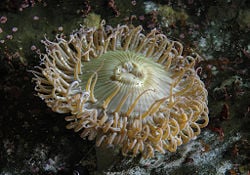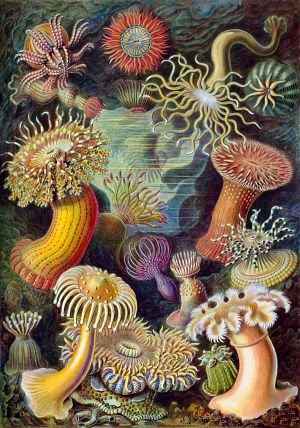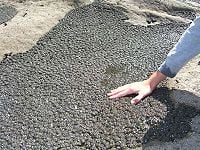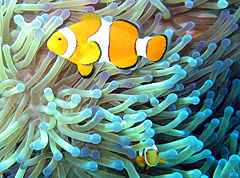Sea anemone
| Sea anemone | ||||||||||
|---|---|---|---|---|---|---|---|---|---|---|
 Sea anemone at the Monterey Bay Aquarium
| ||||||||||
| Scientific classification | ||||||||||
| ||||||||||
| Diversity | ||||||||||
| 46 families | ||||||||||
|
Endocoelantheae |

Named after a terrestrial flower, the anemone, sea anemones form a group of water dwelling, filter feeding animals of the order Actinaria. As a cnidarian, the sea anemone is closely related to corals and jellyfish. Other close relatives of the sea anemone are the solitary, tube-dwelling anemones and the hydras.
Anatomy
A sea anemone is basically the typical polyp: a small sac, attached to the bottom by an adhesive foot, with a column shaped body ending in an oral disc. The mouth is in the middle of the oral disc, surrounded by tentacles armed with many cnidocytes, which are unique cells that function as a defense and as a means to capture prey. Cnidocytes contain cnidae, capsule-like organelles capable of everting, giving phylum Cnidaria its name [1]. The cnidae that sting are called nematocysts. Each nematocyst contains a small vesicle filled with toxins—actinoporins—an inner filament and an external sensory hair. When the hair is touched, it mechanically triggers the cell explosion, that fires a harpoon-like structure which attaches to organisms that trigger it, and injects a dose of poison in the flesh of the aggressor or prey. This gives the anemone its characteristic sticky feeling.
The poison is actually a mix of toxins, including neurotoxins, which serve to paralyze and capture the prey, which is then moved by the tentacles to the mouth/anus for digestion inside the gastrovascular cavity. Actinoporins have been reported as highly toxic to fish and crustaceans, which may be the natural prey of sea anemones. In addition to their role in predation, it has been suggested that actinoporins could act, when released in water, as efficient repellents against potential predators. Clownfish are immune to an anemone's sting.
The internal anatomy of anemones is very simple. There is a gastrovascular cavity (which functions as a stomach) with a single opening to the outside which functions as both a mouth and an anus: waste and undigested matter is excreted through the mouth/anus. A primitive nervous system, without centralization, coordinates the processes involved in maintaining homeostasis as well as biochemical and physical responses to various stimuli. Anemones range in size from less than 1¼ cm (½ in) to nearly 2 m (6 ft) in diameter. They can have a range of 10 tentacles to hundreds.
The muscles and nerves in anemones are much simpler than those of other animals. Cells in the outer layer (epidermis) and the inner layer (gastrodermis) have microfilaments grouped together into contractile fibers. These are not true muscles because they are not freely suspended in the body cavity as they are in more developed animals. Since the anemone lacks a skeleton, the contractile cells pull against the gastrovascular cavity, which acts as a hydrostatic skeleton. The stability for this hydrostatic skeleton is caused by the anemone shutting its mouth closed, which keeps the gastrovascular cavity at a constant volume, making it more rigid.
Life cycle
Unlike other cnidarians, anemones (and other anthozoans) entirely lack the free-swimming medusa stage of the life cycle: the polyp produces eggs and sperm, and the fertilized egg develops into a planula that develops directly into another polyp.
A few anemones are parasitic to marine organisms. Anemones tend to stay in the same spot unless they are unhappy with that location, or a predator is attacking them. In the case of an attack, anemones can uproot themselves and swim away to a new location using flexing motions.
The sexes in sea anemones are separate. Both sexual and asexual reproduction may occur. In sexual reproduction males release sperm which stimulates females to release eggs, and fertilization occurs. The eggs or sperm are ejected through the mouth. The fertilized egg develops into a planula, which finally settles down somewhere and grows into a single anemone. They can also reproduce asexually by budding, binary fission, which involves pulling apart into two halves, and pedal laceration, in which small pieces of the pedal disc break off and regenerate into small anemones. Laceration is a process of fragmentation of the basal disk, or by pulling itself into two parts.
Ecology
The sea anemone has a foot which in most species attaches itself to rocks or anchors in the sand. Some species attach to kelp and others are free-swimming. Although not plants and therefore incapable of photosynthesis themselves, many sea anemones form an important symbiosis with certain single-celled green algae species which reside in the animals' gastrodermal cells. These algae may be either zooxanthellae, zoochlorellae or both. The sea anemone benefits from the products of the algae's photosynthesis, namely oxygen and food in the form of glycerol, glucose and alanine; the algae in turn are assured a reliable exposure to sunlight, which the anemones actively maintain. The preponderance of species inhabit tropical reefs, although there are species adapted to relatively cold waters, intertidal reefs, and sand/kelp environments.
Some sea anemones form symbiotic relationships with crabs, shrimp or with anemone fish, also known as clownfish. In the former situation, anemones will either attach or be attached to the shell of a hermit crab (by the crab's own volition), providing additional protection for the crab and allowing the anemone to eat scraps when the crab feeds. A similar relationship can be formed between a sea anemone and a clownfish. The clownfish presses itself into the anemone, living comfortably within the stinging tentacles. This is possible because of a protective mucus that covers the clownfish. It is not yet fully understood whether the protective mucus impedes the nemtocysts from penetrating the flesh of the clownfish or if the mucus suppresses nematocysts from firing. The clownfish benefits from this symbiotic relationship because it is protected by the anemone and in turn the anemone benefits because it gets food scraps from the clownfish.
Fossil record
Most Actinaria do not form hard parts that can be recognized as fossils but a few fossils do exist; Mackenzia, from the Middle Cambrian Burgess Shale of Canada, is the oldest fossil identified as a sea anemone.
Gallery
- Anemone 590.jpg
Deep–sea anemone
- Beaded Sea Anenome with shrimp.JPG
A shrimp living with a beaded sea anemone
ReferencesISBN links support NWE through referral fees
- ↑ Campbell N. & J. Reece (2002). Biology, 6th ed, San Francisco: Pearson Education.
External links
- Order Actiniaria
- http://www.actiniaria.com/
- Anemone Armies Battle to a Standoff
- Anemone Wars: Clone armies deploy scouts, attack tidally The first description of clashing armies of sea anemones has revealed unsuspected military tactics. 6-4-2005
- Sea anemones look like sea flowers but they are animals of the Phylum Cnidaria
Credits
New World Encyclopedia writers and editors rewrote and completed the Wikipedia article in accordance with New World Encyclopedia standards. This article abides by terms of the Creative Commons CC-by-sa 3.0 License (CC-by-sa), which may be used and disseminated with proper attribution. Credit is due under the terms of this license that can reference both the New World Encyclopedia contributors and the selfless volunteer contributors of the Wikimedia Foundation. To cite this article click here for a list of acceptable citing formats.The history of earlier contributions by wikipedians is accessible to researchers here:
The history of this article since it was imported to New World Encyclopedia:
Note: Some restrictions may apply to use of individual images which are separately licensed.







